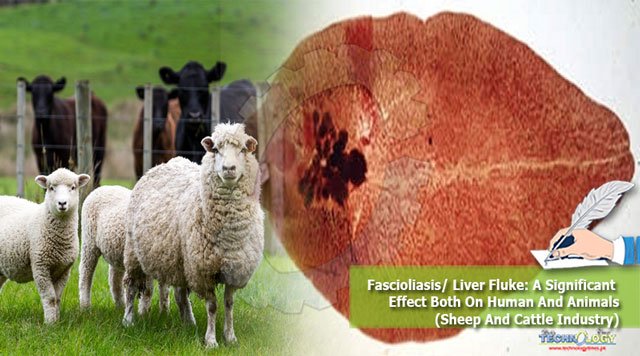Fasciola hepatica is also identified as sheep liver fluke and common liver fluke. Fasciola hepatica is a trematode/fluke belonging to phylum Platyhelminthes.

Dr. Maria Jamil1, Dr. Aisha Khatoon1, Dr. Muhammad Kashif Saleemi1, Dr. Muhammad Tahir Aleem2
It mainly a parasite of the liver of several animals and humans. It has the capability to move along the blood circulation and reach the bile duct, parenchyma of liver and gall bladder and produced pathological lesion leads to parasitic disease. The infection produced by fluke is known as fascioliasis that is a form of helminthiasis and has been categorized as a neglected tropical infection. Fascioliasis is recently categorized as a foodborne disease that is frequently caused by the ingestion of metacercariae that encysted on plants. Fasciola hepatica is dispersed worldwide and leads to huge economic losses for the decade by infecting the sheep and cattle. It has a complex life cycle for the completion of the life cycle required 2-3 hosts.
Life cycle:
Fasciola hepatica occurs in the liver of cattle, sheep, domestic and wild ruminants, as well as humans. It has an indirect life cycle mean required the intermediate host. The intermediate host includes snail from lymaeidae family. From snail released the metacercariae as cercariae and became encysted on several aquatic vegetables. Humans and animals become infected after ingestion of infected vegetables and plants. Then in the duodenum of definitive host metacercariae released from the cyst. Then from intestine migrate to the liver and bile duct. Fasciola hepatica takes 3-4 months to become mature from metacercariae to an adult fluke in humans. About 25000 eggs/fluck/day produced by adult fluke. These eggs are excreted through feces into freshwater. Egg hatch to miracidia and ingested by the snail. In the snail, miracidia converted to sporocyst to rediae to cercariae and then released from the snail and begin the cycle.
Morphology of liver fluke:
Fasciola hepatica is the biggest fluke of the world having 13mm width and 30mm a length some time it can reach up to 75mm in length. Liver fluke is mostly leaf shape wider anteriorly and pointed posteriorly. At the anterior side of the liver fluke small but dominant cone shape, the oral sucker is present.
Sign and symptom of liver fluke in human:
Fascioliasis can be caused by both Fasciola hepatica and Fasciola gigantica.
- Symptom during acute infection in human:
- Swollen liver
- Skin rashes
- Fever
- Nausea
- Extreme abdominal pain
- Symptom during the chronic infection in human:
- Alternating pain
- Jaundice
- Anemia
Sign and symptom of liver fluke in sheep and cattle:
- Anemia
- Persistent diarrhea
- Reduction in weight gain and milk production
- Internal hemorrhages and liver damage leads to sudden death
Pathogenicity of liver fluke in human:
- Inflammation and dilation of bile duct
- Periductal fibrosis, epithelial hyperplasia
- Pyogenic cholangitis and cholangiocarcinoma (cancer), opisthorchiasis, is the prominent cause of cholangiocarcinoma. International Agency of Research on Cancer (IARC) categorized the opisthorchiasis and clonorchiasis as Group 1 human biological agents carcinogen.
Diagnosis of a liver fluke:
- Through fecal examination by identification of yellow-brown eggs in the feces
- ELISA (enzyme-linked immunosorbent assay) through milk, serum and feces
- Western blot/Arc2 immunodiffusion test
- Fasciola hepatica excreted the proteases that can be used as immunizing antigen
Treatment control and prevention of liver fluke:
- Praziquantel is the drug of choice against flukes
- Cattle and sheep are mostly cured by using the flukicides and the chemical that are toxigenic to fluck, which mainly include ivermectin, bithionol, triclabendazole and bromofenfos.
- For prevention of liver fluke infection in endemic areas in human control the sale and growth of water edible plant like watercress.
- Avoid the use of contaminated water for irrigation of vegetable
- Before the consumption vegetables should be properly washed and cooked
- To control the population of snail
Economic impact:
Fasciola hepatica causes huge economic losses in the meat and dairy industry. Over the years, the occurrence of Fascioliasis is enhanced and thought to be continuously enhancing in the future.
Dr. Maria Jamil1, Dr. Aisha Khatoon1, Dr. Muhammad Kashif Saleemi1, Dr. Muhammad Tahir Aleem2 1 Department of Pathology, Faculty of veterinary science, University of Agriculture, Faisalabad 2 MOE Joint International Research Laboratory of Animal Health and Food Safety, College of Veterinary Medicine, Nanjing Agricultural University, 210095 Nanjing, P.R.China
